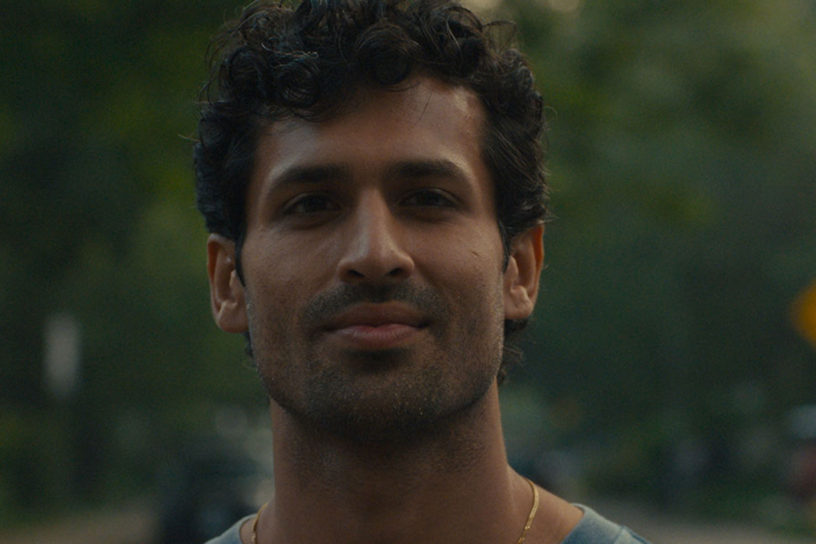By Emerson Williams
There is something incredibly refreshing about seeing Toronto play itself for once in Amar Wala’s Shook.
Like that one person in your romantic roster, Toronto is typically the reliable, budget-friendly booty call of filmmaking, ready to be dressed up like New York City for a fraction of the price and effort.
This time, Scarborough-born Wala gave the city its flowers in his leap from documentary filmmaking to narrative fiction. He even worked with other Canadians like producer and Toronto Metropolitan University professor Karen Harnisch.
Written and directed by Wala, Shook follows Scarborough resident Ash (Saameer Usmani) coming to terms with his father Vijay’s (Bernard White) diagnosis of Parkinson’s disease, all while falling in love with local barista Claire (Amy Forsyth), cultivating his writing career and balancing his tumultuous relationship with his mother Nisha (Pamela Sinha).
The piece showcases Torontonian relatability through its intermittent comedy. The film shows the debilitating commuter lifestyle for those on the city’s ends and a touching appearance of the now deceased Scarborough Line 3. The script is laced with distaste for the Québécois and cuss-filled jokes that could only come from a Torontonian’s mouth.
The true selling point of the film is its cinematography. There is no denying that Wala has a talented eye for shots, angles and framing. Paired with the talents of cinematographer Peter Hadfield, the film is a dynamic piece that prioritizes pleasing the eyes of the viewer.
But from there, Wala’s artistic dedication begins to noticeably dwindle.
Wala and co-writer Adnan Khan gave themselves a lot to work with and they seemed to have realized that too. The film’s theme of closing distance and breaking down walls transpires in many ways but primarily through the closeness Ash achieves with estranged Vijay after his diagnosis.
The themes are also established through Ash finding identity in Toronto despite feeling like an outcast all his life as a Scarborough resident. Shook’s cinematography constantly features shots showing distance, whether it’s downtown on the Scarborough skyline or a glowing subway tunnel as the train moves further away.
It almost feels as if Wala and Khan didn’t know where to land, what part of the plot to bring out the most to achieve the movie’s ideas or even what Ash’s emotional growth should look like.
Instead of going on a journey with Ash as he tries to find where he stands in life, the audience is gifted with Ash’s struggles in the form of ornaments that make him appear more moody and deep.
There is no sinking into the plot, there is merely floating atop the shallow storyline.
This would be less of a problem if Ash wasn’t so difficult to care about. Be warned that he possesses very little to invest love or hatred into. At Shook’s premiere, Wala noted that Ash was intended to come off as misogynistic. Though a brief glimpse of this could be seen in Ash’s relationship with his mother, it’s difficult to narrow it down to a distinct trait—especially since Ash spends most of his time whining and demanding pity from everybody regardless of their gender.
Perhaps more about Ash could be understood if the emotions he is forced to confront with his father’s Parkinson’s diagnosis were not secondary to the mainplot of falling for Claire.
Ash’s relationship with Claire is applicable to the themes of the film, but it would be a distant conncetion. Though Forsyth stands out vividly with her flawless embodiment of Claire, it’s difficult to believe that Ash and Claire are romantically involved. This is especially true since they share limited vulnerability and express no takeaways from the stakes of Ash discovering Claire has departed for Montreal only shortly after the birth of their entanglement.
Shook features many heartwarming scenes that shed light on Parkinson’s disease, featuring several short appearances from Canadians living with the disorder. However, Wala fails to depict how the disease creates any closeness between Ash and Vijay, aside from Ash experiencing guilt at the prospect of not being by his father’s side through treatment.
Based on Wala’s understanding of Ash’s misogynistic tendencies, this could be extrapolated as a choice to showcase men who find it difficult to be emotionally vulnerable with each another. Determining this bias solely based on afterthought could be a frustrating responsibility to bestow upon an audience. But there is a grand chance that Wala did expect this from his audience, almost as if to be a thoughtless writer in auteurist clothing.
This would be corroborated by Ash’s childish display surrounding his parent’s separation, which could make any sensible adult question why he centres himself in the ordeal as a man in his late 20s. Perhaps Wala intended to provide a commentary on the importance of marriage. Rather, it may just be that he could have done this to broaden his story, but chose not to.
If there is anything that will please the audiences of Shook, it will be that the film offers reassurance to post-grads in their late 20s and 30s that they can still go to house parties and get blackout drunk.












Leave a Reply